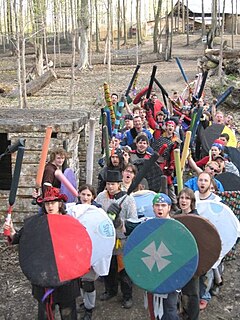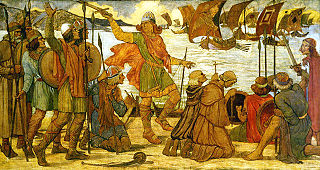
A knight is a person granted an honorary title of knighthood by a head of state or representative for service to the monarch, the church or the country, especially in a military capacity. Knighthood finds origins in the Greek hippeis and hoplite (ἱππεῖς) and Roman eques and centurion of classical antiquity.

A longsword is a type of European sword characterized as having a cruciform hilt with a grip for primarily two-handed use, a straight double-edged blade of around 85 to 110 cm, and weighing approximately 1 to 1.5 kg.

Jousting is a martial game or hastilude between two horse riders wielding lances with blunted tips, often as part of a tournament. The primary aim was to replicate a clash of heavy cavalry, with each participant trying to strike the opponent while riding towards him at high speed, breaking the lance on the opponent's shield or jousting armour if possible, or unhorsing him. The joust became an iconic characteristic of the knight in Romantic medievalism. The participants experience close to three and a quarter times their body weight in G-forces when the lances collide with their armour.

Stage combat, fight craft or fight choreography is a specialised technique in theatre designed to create the illusion of physical combat without causing harm to the performers. It is employed in live stage plays as well as operatic and ballet productions. With the advent of cinema and television the term has widened to also include the choreography of filmed fighting sequences, as opposed to the earlier live performances on stage. It is closely related to the practice of stunts and is a common field of study for actors. Actors famous for their stage fighting skills frequently have backgrounds in dance, gymnastics or martial arts training.

Swordsmanship or sword fighting refers to the skills and techniques used in combat and training with any type of sword. The term is modern, and as such was mainly used to refer to smallsword fencing, but by extension it can also be applied to any martial art involving the use of a sword. The formation of the English word "swordsman" is parallel to the Latin word gladiator, a term for the professional fighters who fought against each other and a variety of other foes for the entertainment of spectators in the Roman Empire. The word gladiator itself comes from the Latin word gladius, which is a type of sword.

Amtgard is a battle gaming and live-action fantasy roleplaying and boffer combat game with chapters primarily based in the United States and Canada as well as Germany, Croatia, and South Korea.

Knowledge about military technology of the Viking Age is based on relatively sparse archaeological finds, pictorial representation, and to some extent on the accounts in the Norse sagas and laws recorded in the 14th century.
Codex Belli is the name of a set of rules for medieval combat reenactment first issued in 1999 and then revised by the German umbrella group Kämpferliste in 2002.

Medieval reenactment is a form of historical reenactment that focuses on re-enacting European history in the period from the fall of Rome to about the end of the 15th century. The second half of this period is often called the Middle Ages. This multiplicity of terms is compounded by the variety of other terms used for the period.

Combat reenactment is a side of historical reenactment which aims to depict historical forms of combat. This may refer to either single combat, melees involving small groups, or nearly full-scale battles with hundreds of participants.
Rapier Combat is a style of historical fencing practiced in the Society for Creative Anachronism (SCA). The primary focus is to study, replicate and compete with styles of rapier sword-fighting found in Europe during the Renaissance period, using blunted steel swords and a variety of off-hand defensive items. Participants wear period clothing while competing, along with or incorporating protective equipment for safety. In the April 2020 update of the rules, the sport was renamed 'Fencing Combat'.

Jugger is a sport inspired by the 1989 film The Salute of the Jugger, in which a game of the same name is played. The film version was invented by the film's writer-director, David Webb Peoples, especially for the movie. The transformation into a real sport happened independently in Germany and Australia.
The Society for Creative Anachronism (SCA) is a medieval reenactment group with an international membership, founded in California in 1966. Members of the group participate, to a greater or lesser extent, in a wide variety of activities based on those found in pre-1601 CE cultures. The vast majority of interests in the SCA are either combat-focused, or focused on the day-to-day crafts of the period, known within the Society as A&S. Gatherings of the SCA are events, at which attempts at pre-17th century costume must be worn, and practices or meetings, at which costuming is largely up to each member's discretion—although sufficient safety equipment must always be worn for practicing combat skills.

A coat of plates is a form of segmented torso armour consisting of overlapping metal plates riveted inside a cloth or leather garment. The coat of plates is considered part of the era of transitional armour and was normally worn as part of a full knightly harness. The coat saw its introduction in Europe among the warring elite in the 1180s or 1220s and was well established by the 1250s. It was in very common usage by the 1290s. By the 1350s it was universal among infantry militias as well. After about 1340, the plates covering the chest were combined to form an early breastplate, replacing the coat of plates. After 1370, the breastplate covered the entire torso. Different forms of the coat of plates, known as the brigandine and jack of plates, remained in use until the late 16th century.

SCA armoured combat, or informally heavy combat, is a combat sport developed by the Society for Creative Anachronism (SCA) in which participants in protective body armour compete in mock combat, individual tournaments inspired by forms of historical combat, and tournament combat practiced in medieval Europe. Groups also compete, under supervision, in group battles which may approximate historically real combat, using SCA approved safe weapons. Combats are performed under the watch of marshals to maintain safety. It is variously considered a combat sport, contact sport, or a form of martial art.
Italian martial arts include all those unarmed and armed fighting arts popular in Italy between the Bronze age until the 19th century AD. It involved the usage of weapons. Each weapon is the product of a specific historical era. The swords used in Italian martial arts range from the Bronze daggers of the Nuragic times to the gladius of the Roman legionaries to swords which were developed during the renaissance, the baroque era and later. Short blades range from medieval daggers to the liccasapuni Sicilian duelling knife.
The Battle of the Nations is an international historical medieval battles world championship, first held in 2009, in Khotyn, Ukraine and held in Europe, in April, every year since.
Historical Medieval Battles (HMB) or Buhurt or Armored Combat is a modern full contact fighting sport with steel blunt weapons characteristic for the Middle Ages. Armour and weapons have to follow regulations on historical authenticity and safety published on official Battle of the Nations website.
Tobias Emanuel ("Toby") Capwell FSA is an American historian who lives and works in London. His principal interest is in European arms and armour of the medieval and Renaissance periods. He is Curator of Arms and Armour at the Wallace Collection in London. He has written and spoken extensively on both the historical and the practical aspects of his subject. He is a skilled jouster, and has claimed to be the world's only jousting curator.












